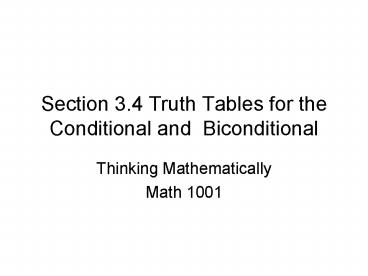Section 3'4 Truth Tables for the Conditional and Biconditional - PowerPoint PPT Presentation
1 / 19
Title:
Section 3'4 Truth Tables for the Conditional and Biconditional
Description:
Use a truth table to determine if a compound statement is a tautology. ... Conditional statements that are tautologies are called implications. ... – PowerPoint PPT presentation
Number of Views:242
Avg rating:3.0/5.0
Title: Section 3'4 Truth Tables for the Conditional and Biconditional
1
Section 3.4 Truth Tables for the Conditional and
Biconditional
- Thinking Mathematically
- Math 1001
2
Objectives
- Understand the logic behind the definition of the
conditional. - Construct truth tables for conditional
statements. - Write a conditional statement in an equivalent
form. - Use a truth table to determine if a compound
statement is a tautology.
- Understand the definition of the biconditional.
- Construct truth tables for biconditional
statements. - Construct truth tables for statements consisting
of three simple statements. - Determine the truth value of a compound statement
for a specific case.
3
Conditional Statements, ?
- If you pass the final, then you pass the course.
- p You pass the final.
- q You pass the course.
T
F
T
T
4
The Definition of the Conditional (page 116)
- In the conditional
- p ? q
- p is the antecedent
- q is the consequent
- antecedent ? consequent
- A conditional is false only when the antecedent
is true and the consequent is false.
5
Truth table for q ? p
T
F
T
T
Only false when antecedent is true and the
consequent is false.
6
A Statement that is Equivalent to the Conditional
- If you pass the final, then you pass the course.
- p You pass the final.
- q You pass the course.
- p ? q
- If you do not pass the course, then you did not
pass final. - p You pass the final.
- q You pass the course.
- q ? p
The Truth value of a conditional statement does
not change if the antecedent and the consequent
are reversed and negated.
7
Truth table for (pVq)p ? q
T
A tautology is a compound statement that is
always true.
T
T
T
Only false when antecedent is true and the
consequent is false.
8
Definition of Tautology (page 118)
- A tautology is a compound statement that is
always true. - To determine if a compound statement is a
tautology construct a truth table. - If the last column is always true then the
statement is a tautology. - Conditional statements that are tautologies are
called implications.
9
Biconditional Statements
- ? translates into if and only if
- p ? q means p?q and q?p
- p?q q?p
10
Truth table for (p?q) (q?p)
T
T
T
F
F
F
T
T
Only false when antecedent is true and the
consequent is false.
11
Example 6 Constructing a Truth Table with Eight
Cases (page 121)
T
T
T
F
F
T
T
F
F
T
F
T
F
T
F
T
Only false when antecedent is true and the
consequent is false.
12
Section 3.4 Homework
- 1 60
13
Construct a truth table for p ? q
14
2. Construct a truth table for p ? q
15
5. Construct a truth table for (p q) ? (p V q)
16
21. Construct a truth table for (p q) (p V
q)
17
Four Case Problem
18
42. (p V q) ? r
19
Eight Case Problem































